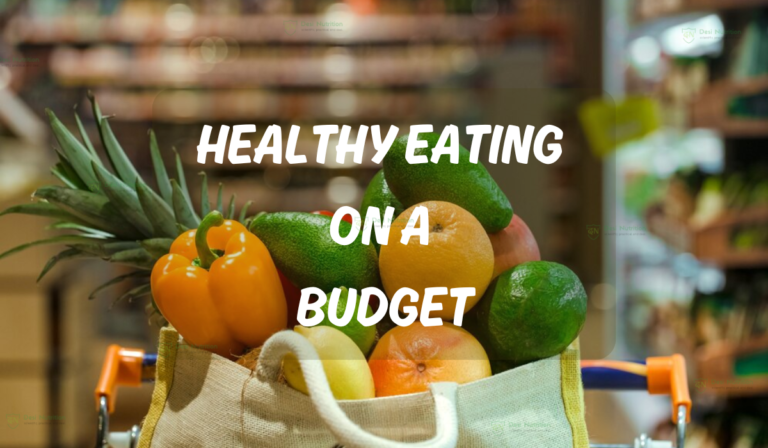Everyone is running after eating healthy but who is actually eating healthy food, especially when you are on a budget? If we look at it, healthy eating is not that difficult. In this article, we will explore how one can focus on healthy eating on a budget.
One thing that we want to mention here is that healthy eating is not expensive. All you need is strategic and smart planning to work on your nutritious meals. Let’s explore various ways you can actually eat healthy without breaking the bank.

1. Plan Your Meals Ahead
The most effective way is to plan your meals ahead of time. It will give you an idea of the ingredients you already have and the ones you would need to buy so you can focus on healthy eating on a budget.
- Make a Weekly Menu: Creating a weekly menu for your meals will help to ensure that you use ingredients efficiently and avoid unnecessary purchases.
- Include Versatile Ingredients: Go for various alternatives. Do not stick to the same ingredients for the whole week. Bring changes to your meals by opting for ingredients like beans, eggs, rice, oats, and vegetables that can be used in various recipes. This cuts down on waste and stretches your budget.
- Cook in Batches: Prepare meals in large quantities and freeze portions for future use. Not only does this save time, but it also reduces food spoilage and dining-out costs.
2. Shop Smart with a Grocery List
A shopping list will help you stick to a budget. When you are short of money or want to make sure you don’t spend too much, make sure you are going with a grocery list in your hand. Go straight to the aisle where you know you might find the products that you need or take someone’s help in the grocery store.
- Stick to the List: while shopping make sure you stick to the list. Shopping with a list reduces impulse buys, which are often pricier and less nutritious.
- Plan Around Sales: If you want to buy in bulk you can plan your shopping around sales that will help save the money. Look for weekly store deals and plan meals around discounted items. Many stores offer digital coupons that can further reduce costs.
- Choose Store Brands: Generic or store brands are often made by the same manufacturers as name brands but cost less. You can buy your basic items there like grains.
3. Buy in Bulk for Staple Ingredients
You are going to need some staple ingredients for a long time. So you can buy them in bulk as it will be easy for you to store them at your place instead of buying them again and again.
- Choose Bulk Sections: Buy the Items like rice, lentils, beans, oats, and nuts as they can be cheaper when bought in bulk. They have a long shelf life, making them ideal for budget-friendly, nutrient-dense meals.
- Utilize Discount Memberships: There are stores that offer membership discounts and also have some other ways to get discounts for their regular customers. If you have a larger household or storage space, a discount membership store (like Costco) can save money on bulk buys, especially for items like whole grains, frozen vegetables, and healthy snacks.
- Store Properly: Buying bulk items will only be beneficial for you if you store them properly. Make sure you use airtight containers to prevent spoilage and maintain freshness.
4. Prioritize Whole, Unprocessed Foods
One of the effective ways to afford nutritious meals is to buy whole and unprocessed foods.
- Fresh vs. Processed: you need to prioritize whole and unprocessed foods because first, they are nutritious and second they are affordable that pre-packaged or processed foods which usually come in premium price.
- Seasonal Produce: Opt for seasonal produce because they will be available in bulk already making them affordable to buy. For example, apples in the fall and berries in the summer are typically more affordable and flavorful when they’re locally grown.
- Frozen Fruits and Vegetables: Choose frozen fruits and vegetables if you want to store them for longer. These are nutritious, cost-effective, and long-lasting. They’re picked at peak ripeness and flash-frozen, which helps retain nutrients. Frozen vegetables can be added to soups, stir-fries, and smoothies with no extra prep.
5. Use Plant-Based Proteins
You need protein for your body but storing animal-based protein could be a bit challenging. Therefore, opt for plant-based protein sources that are easy to store and affordable as well.
- Affordable Protein Sources: Plant-based protein is affordable. Beans, lentils, chickpeas, and tofu are nutrient-dense, inexpensive alternatives to animal proteins. They also provide essential fiber, making meals more filling; therefore, you won’t feel hungry often.
- Mix It Up with Eggs and Dairy: Eggs and dairy are again an effective food product that are nutritious and could be bought in bulk. Eggs are packed with protein and versatile for any meal of the day, while Greek yogurt provides protein, calcium, and probiotics and can be used in both sweet and savory dishes.
- Make Meat Go Further: If you do consume meat, buy larger cuts (like whole chickens) and use them in several meals, or incorporate smaller amounts in recipes by combining with plant-based proteins so you can have a balanced meal on budget.
6. Cook at Home and Experiment with Simple Recipes
Cooking at home saves you a lot of money. Even if you don’t want to cook at home there are healthy food delivery services that you can subscribe to to get healthy meals.
- Home-Cooked Meals: Prepare your meals at home because it is healthier and cheaper than eating out. Look for recipes that require minimal ingredients and can be prepared in large batches.
- Embrace One-Pot Meals: One-pot meals would be easy for you to cook and affordable as well. Dishes like soups, stews, and casseroles are filling, require fewer ingredients, and save time on cleanup. They’re also easy to adapt based on available ingredients.
- Utilize Leftovers Creatively: Your leftovers could be very useful when it comes to nutritious and affordable meal cooking. Repurpose leftovers to create new meals. For example, use leftover vegetables in a stir-fry, add cooked grains to a salad, or incorporate last night’s protein in a wrap or sandwich.
7. Avoid Food Waste with Creative Meal Prep
Food waste is an issue for many people. They do sometimes waste food without realizing that they are also wasting their money. If you want to focus on healthy eating on a budget ensure to avoid food wastage. Opt for creative meal prep.
- Freeze Extra Portions: Freezing ingredients is an effective way to increase their shelf life. You can freeze fruits for smoothies and meats or grains can be stored for future use.
- Use All Parts of Ingredients: Do you know you can use all parts of the ingredients. Yes you can even use stems or leaves of some of the plants. Incorporate less popular parts of vegetables (like stems or leaves) into soups or smoothies. Save bones from meats to make nutritious broths.
- Know Expiration Dates: Organizing your pantry can help you be on a budget. Make sure to keep items with closer expiration dates at the front. This helps prevent spoilage and ensures you’re using up ingredients before they go bad.
8. Healthy Budget-Friendly Recipe Ideas
Here are a few simple ideas for healthy eating on a budget:
- Breakfast: You can have overnight oats with fresh or frozen berries, nuts, and a touch of honey for your breakfast.
- Lunch: For lunch have a balanced meal and include chickpea salad wrap with seasonal greens, cucumbers, and a tangy yogurt dressing.
- Dinner: Make lentil and vegetable stew with a side of brown rice or quinoa for your dinner.
- Snacks: Have healthy snacks like roasted chickpeas, homemade granola bars, or fresh fruits with nut butter.
Frequently Asked Questions
Is it possible to eat healthy on a budget?
Ans. Yes, it is possible for you to eat healthy on a budget. In fact, eating healthy food is more affordable than pre-packed foods or unprocessed foods.
How to start healthy eating as a beginner?
Ans. You can start healthy eating by including more fruits and vegetables in your diet. Focus on whole grains like brown rice, quinoa, barley etc to include in your meals. Slowly and gradually reduce the intake of processed foods and take-outs.
What diet is best for beginners?
Ans. The diet you will follow will majorly depend on your health goals. You can consult a dietician for a well-planned diet. But if you want to start with a basic diet as a beginner. Make sure you eat a clean diet which consists of fresh fruits and vegetables, whole grains, and such natural foods.




